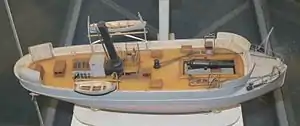Ant-class gunboat
The Ant-class gunboat was a class of twenty-four Royal Navy flat-iron gunboats mounting a single 10-inch gun, built between 1870 and 1880.[1] They carried no masts or sails, being among the first Royal Navy vessels not to do so. The last four vessels were ordered separately and are sometimes known as the Gadfly class, although they were essentially identical. Members of the class lingered on as steam lighters, dredgers, boom defence vessels and base ships, lasting in some cases into the 1950s.
 A model of HMS Arrow | |
| Class overview | |
|---|---|
| Name | Ant class |
| Builders |
|
| Operators | |
| Preceded by | HMS Plucky |
| Succeeded by | Medina class |
| Subclasses | Gadfly class |
| Built | 1870 - 1879 |
| In commission | 1870 - 1959 |
| Completed | 24 |
| General characteristics | |
| Type | Flat-iron gunboat |
| Displacement | 254 tons standard |
| Length | 85 ft (26 m) |
| Beam | 26 ft 1.5 in (7.963 m) |
| Draught | 6 ft (1.8 m) |
| Installed power | 260 ihp (190 kW)[1] |
| Propulsion |
|
| Speed | 8.5 kn (15.7 km/h)[1] |
| Crew | 30[1] |
| Armament | One 10-inch (18 ton) muzzle-loading rifle[1] |
Design
The flat-iron gunboats were designed for coastal defence and bombardment, and were constructed from iron. They were not rigged, and the single 10-inch (18 ton) muzzle-loading rifle was fitted forward on a hydraulic mount that allowed it to be lowered for a sea passage to improve the vessel's seaworthiness, and raised for action.[1] Power was provided by a pair of two-cylinder horizontal single-expansion steam engines driving twin screws. Together they developed 260 indicated horsepower (190 kW), giving a top speed of about 8.5 knots (15.7 km/h).[1]
Ships
.jpg.webp)
| Name | Ship Builder | Launched | Fate |
|---|---|---|---|
| Blazer | Portsmouth Dockyard | 7 December 1870 | Became seagoing tender for weapons testing in 1904. Gunboat August 1914. Sold to W Loveridge, West Hartlepool 19 August 1919. |
| Comet | Portsmouth Dockyard | 8 December 1870 | Sold to J Pas on 12 May 1908 and broken up in the Netherlands |
| Bustard | Robert Napier & Sons, Govan | 7 January 1871 | Sold to Thos. W. Ward, Milford Haven March 1923 |
| Kite | Robert Napier & Sons, Govan | 8 February 1871 | Sold in a partially dismantled state to Hughes Bolckow on 18 May 1920 and converted to a dredger |
| Scourge | Chatham Dockyard | 25 March 1871 | Converted to tank vessel, renamed C79 in 1903-4 and still listed as in service in 1930 |
| Snake | Chatham Dockyard | 25 March 1871 | Completed as a cable lighter, renamed YC15 on 23 September 1907 |
| Mastiff | Charles Mitchell and Co, Walker | 4 April 1871 | Renamed Snapper in 1914, sold to Thames Shipbreakers Ltd on 28 November 1931 |
| Bloodhound | Charles Mitchell and Co, Walker | 22 April 1871 | Boom defence vessel in 1917, sold to F Bevis Ltd on 28 June 1921 |
| Arrow | J & G Rennie, Greenwich | 22 April 1871 | Sold to W H Webber on 1 March 1922 |
| Bonetta | J & G Rennie, Greenwich | 20 May 1871 | Sold on 12 January 1909 as salvage vessel Disperser and lost in April 1940 |
| Badger | Chatham Dockyard | 13 March 1872 | Sold to W Loveridge, West Hartlepool on 6 October 1908 |
| Fidget | Chatham Dockyard | 13 March 1872 | Hulked or sold in 1905 |
| Bulldog | Campbell Johnston, North Woolwich | 17 September 1872 | Sold to R Gillham on 16 July 1906 |
| Pike | Campbell Johnston, North Woolwich | 16 October 1872 | Boom defence vessel at Southampton in 1908, sold to G Sharpe on 27 March 1920 |
| Pickle | Campbell Johnston, North Woolwich | 15 November 1872 | Dockyard lighter in 1906 |
| Snap | Campbell Johnston, North Woolwich | 11 December 1872 | Sold at Chatham to Deaker, Hull in 1909 |
| Ant | Laird Brothers, Birkenhead | 14 August 1873 | Boom defence vessel 1917, used as a target in 1921, sold to Granton Shipbreaking Company for breaking up on 2 June 1926 |
| Cuckoo | Laird Brothers, Birkenhead | 14 August 1873 | Became base ship, renamed Vivid on 19 February 1912, Vivid II in January 1922, YC37 in 1923 and finally sold to Hocking, Plymouth in 1959 |
| Hyaena | Laird Brothers, Birkenhead | 30 August 1873 | Sold at Chatham to Adrienne Merveille of Dunkirk on 3 April 1906 |
| Weazel | Laird Brothers, Birkenhead | 4 September 1873 | Became oil fuel lighter C118 in 1904 |
| Gadfly | Pembroke Dock | 5 May 1879 | Converted to a coal lighter at Simonstown, completing on 18 May 1900 and then renamed YC230. Sold at the Cape in 1918 |
| Pincher | Pembroke Dock | 5 May 1879 | Sold at Portsmouth on 11 June 1905 |
| Griper | Pembroke Dock | 15 September 1879 | Became steam lighter YC373 in 1905, renamed Flora on 19 June 1923 as base ship, then Afrikander in 1933. Believed to have been broken up at the Cape in 1951 |
| Tickler | Pembroke Dock | 15 September 1879 | Converted to steam lighter at Simonstown in 1902, renamed Afrikander as base ship on 26 February 1919, then Afrikander II in 1933. Broken up at Simonstown in 1937 |
References
- Colledge, J. J.; Warlow, Ben (2006) [1969]. Ships of the Royal Navy: The Complete Record of all Fighting Ships of the Royal Navy (Rev. ed.). London: Chatham Publishing. ISBN 978-1-86176-281-8.